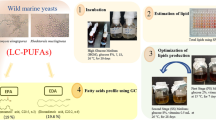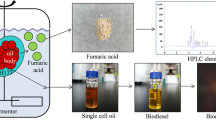Abstract
The filamentous fungi of the genus Mortierella are known to produce arachidonic acid from glucose, and the species alpina is currently used in industrial production of arachidonic acid in Japan. In anticipation of a large excess of the co-product glycerol from the national biodiesel program, we are trying to find new uses for bioglycerin. We screened 12 Mortierella species: M. alpina NRRL 6302, M. claussenii NRRL 2760, M. elongata NRRL 5246, M. epigama NRRL 5512, M. humilis NRRL 6369, M. hygrophila NRRL 2591, M. minutissima NRRL 6462, M. multidivaricata NRRL 6456, M. nantahalensis NRRL 5216, M. parvispora NRRL 2941, M. sepedonioides NRRL 6425, and M. zychae NRRL 2592 for their production of arachidonic acid (AA) and dihomo-γ-linolenic acid (DGLA) from glycerol. With glucose as substrate all of the strains tested produced AA and DGLA. The total fatty acid content of 125 mg/g cell dry weight (CDW) and fatty acid composition for AA (19.63%) and DGLA (5.95%) in the mycelia of M. alpina grown on glucose were comparable with those reported by Takeno et al. (Appl Environ Microbiol 71:5124–5128, 2005). With glycerol as substrate all species tested grew on glycerol and produced AA and DGLA except M. nantahalensis NRRL 5216, which could not grow on glycerol. The amount of AA and DGLA produced were comparable with those obtained with glucose-grown mycelia. The top five AA producers (mg AA/CDW) from glycerol were in the following order: M. parvispora > M. claussenii > M. alpina > M. zychae > M. minutissima. The top five dry mycelia weights were: M. zychae > M. epigama > M. hygrophila > M. humilis > M. minutissima. The top five species for total fatty acids production (mg /g CDW) were: M. claussenii > M. parvispora > M. minutissima > M. hygrophila > M. maltidivaricata. We selected two species, M. alpina and M. zychae for further studies with glycerol substrate. Their optimum production conditions were determined. Time course studies showed that the maximum cell growth and AA production for both species were at 6 days of incubation. Therefore, glycerol can be considered for industrial use in the production of AA and DGLA.

Similar content being viewed by others
References
Horrobin DF (1992) Nutritional and medical importance of γ-linolenic acid. Prog Lipid Res 31:163–194
Jereonkitongkol S, Kawashima H, Shirasaka N, Shimizu S, Yamada H (1992) Production of dihomo-γ-linoleic acid by a Δ5-desaturase-defective mutant of Mortierella alpina 1S-4. Appl Environ Microbiol 58:2196–2200
Jereonkitongkol S, Shimizu S, Yamada H (1993) Occurrence of two nonmethylene-interrupted Δ5 polyunsaturated fatty acids in a Δ6-desaturase-defective mutant of the fungus Mortierella alpina 1S-4. Biochem Biophys Acta 1167:137–141
Jereonkitongkol S, Shimizu S, Yamada H (1993) Production of an eicosapentaenoic acid-containing oil by a Δ12 desaturase-defective mutant of Mortierella alpina 1S-4. J Am Oil Chem Soc 70:119–123
Needleman P, Turk J, Jakschik BA, Morrison AR, Lefkowith JB (1986) Arachidonic acid metabolism. Annu Rev Biochem 55:69–102
Sakuradani E, Kobayashi M, Ashikari T, Shimizu S (1999) Identification of Δ12-fatty acid desaturase from arachidonic acid-producing Mortierella fungus by heterologous expression in yeast Sacharomyces serevisiae and the fungus Aspergillus oryzae. Eur J Biochem 261:812–820
Sakuradani E, Kobayashi M, Shimizu S (1999) Δ6-Fatty acid desaturase from an arachidonic acid-pproducing Mortierella fungus. Gene cloning and its heterologous expression in a fungus Aspergillus. Gene 238:445–453
Sakuradani E, Kobayashi M, Shimizu S (1999) Δ9-Fatty acid desaturase from arachidonic acid-producing fungus. Unique gene sequence and its heterologous expression in a fungus, Aspergillus. Eur J Biochem 260:208–216
Shimizu S, Ogawa J, Kataoka M, Kobayashi M (1997) Screening of novel microbial enzymes for the production of biologically and chemically useful compounds. In: Shepter T (ed) Advances in biochemical engineering/biotechnology, vol 58. Springer, Berlin, pp 45–87
Smith WL, Borgeat P (1985) The eicosanoids: prostagrandins, thromboxanes, leukotrienes, and hydroxyl-eicosanoic acid. In: Vance DE, Vance JE (ed) Biochemistry of lipids and membrances. Benjamin/Cummings, Menlo Park, pp 326–360
Takeno S, Sakuradani E, Tomi A, Inohara-Ochiai M, Kawashima H, Ashikari T, Shimizu S (2005) Improvement of the fatty acid composition of an oil-producing filamentous fungus, Mortierella alpine 1S-4, through RNA interference with Δ-12-desaturase gene expression. Appl Environ Microbiol 71:5124–5128
Wynn JP, Hamid AA, Ratledge C (1999) The role of malic enzyme in the regulation of lipid accumulation in filamentous fungi. Microbiology 145:1911–1917
Wynn JP, Ratledge C (2000) Evidence that the rate-limiting step for the biosynthesis of arachidonic acid in Mortierella alpine is at the level of the 18:3 to 20:3 elongase. Microbiology 146:2325–2331
Yamada H, Shimizu S, Shinmen Y (1987) Production of arachidonic acid by Mortierella elongate 1S-5. Agric Biol Chem 51:785–790
Acknowledgments
We thank Ms. Amy Martinez for her excellent technical assistance and Dr. Kerry O’Donnell of theARS Culture Collection for providing the Mortierella cultures. The mention of firm names or trade products does not imply that they are endorsed or recommended by the US Department of Agriculture over other firms or similar products not mentioned.
Author information
Authors and Affiliations
Corresponding author
Rights and permissions
About this article
Cite this article
Hou, C.T. Production of arachidonic acid and dihomo-γ-linolenic acid from glycerol by oil-producing filamentous fungi, Mortierella in the ARS culture collection. J Ind Microbiol Biotechnol 35, 501–506 (2008). https://doi.org/10.1007/s10295-008-0308-y
Received:
Accepted:
Published:
Issue Date:
DOI: https://doi.org/10.1007/s10295-008-0308-y




